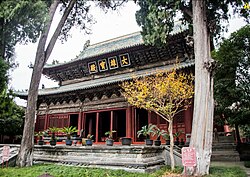Pingwu County
Pingwu County
平武县 | |
|---|---|
 Bao'en Temple in Pingwu County | |
 Location of Pingwu County (red) and Mianyang City (yellow) in Sichuan | |
| Coordinates: 32°24′36″N 104°33′22″E / 32.410°N 104.556°E | |
| Country | People's Republic of China |
| Province | Sichuan |
| Prefecture-level city | Mianyang |
| County seat | Long'an (龙安镇) |
| Area | |
| • Total | 5,974 km2 (2,307 sq mi) |
| Population (2004) | |
| • Total | 190,000 |
| • Density | 32/km2 (82/sq mi) |
| Time zone | UTC+8 (China Standard) |
| Postal code | 622550 |
| Area code | 0816 |
| Website | pingwu |
Pingwu County (Chinese: 平武县; pinyin: Píngwǔ Xiàn) is a county in the north of Sichuan province, China, bordering Gansu province to the north. It is the northernmost county-level division of the prefecture-level city of Mianyang.
It has an area of 5,959.71 km2 (2,301.06 sq mi)[1] and a population of 190,000 in 2004.[2]
Administrative divisions

Pingwu County has six towns, two townships, and twelve ethnic townships.[3]
Towns
Pingwu County's six towns are Long'an, Gucheng, Xiangyan, Daqiao, Shuijing, and Jiangyouguan.[3]
Townships
Pingwu County's two townships are Gaocun Township and Bazi Township.[3]
Ethnic townships
Pingwu County has twelve ethnic townships, of which, four have been designated as Qiang ethnic townships, and eight have been designated as Tibetan ethnic townships.[3]
The county's ethnic townships are Suojiang Qiang Ethnic Township, Tucheng Tibetan Ethnic Township, Jiubu Qiang Ethnic Township, Kuoda Tibetan Ethnic Township, Huangyangguan Tibetan Ethnic Township, Huya Tibetan Ethnic Township, Si'er Tibetan Ethnic Township, Baima Tibetan Ethnic Township, Muzuo Tibetan Ethnic Township, Mupi Tibetan Ethnic Township, Doukou Qiang Ethnic Township, and Pingtong Qiang Ethnic Township.[3]
Demographics
Languages
Pingwu County is one three counties in Sichuan where the Baima language is spoken.[4]
Attractions
Pingwu county is the center of the biggest remaining giant panda habitat in China, i.e. the Minshan Mountains. Close to the Baima Ethnic Township, for example, the national panda reserve "Wanglang" is located. The WWF has conducted an Integrated Community Development Project in the Baima township to reduce direct and indirect poaching threats to the panda population. A temple named "Baoensi" is also located there.
Fauna
There are two species of Megophryidae frogs endemic to Pingwu County, namely Scutiger pingwuensis and Oreolalax chuanbeiensis.
See also
References
- ^ (in Chinese) Geography of Pingwu County Archived 2008-11-23 at the Wayback Machine, Official website of Pingwu County Government, visited on May 14, 2008.
- ^ (in Chinese) Profile of Pingwu County.
- ^ a b c d e 2020年统计用区划代码 [2020 Statistical Division Codes] (in Chinese). National Bureau of Statistics of China. 2020. Archived from the original on 2021-02-17. Retrieved 2021-02-17.
- ^ "Baima". endangeredlanguages.com. Endangered Languages Project. Retrieved 2021-02-17.
{{cite web}}: CS1 maint: url-status (link)
